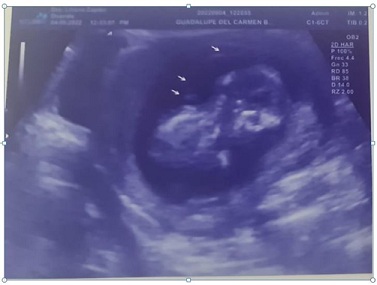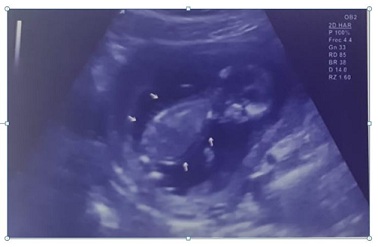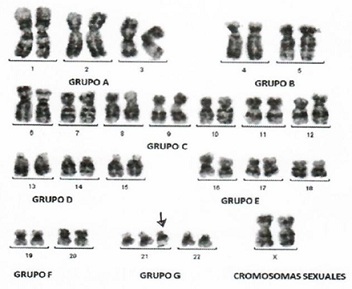
Cystic Hygroma, Hydrops Fetalis and Down Syndrome: A Case Report
*Corresponding Author(s):
Baeza-Flores GDCUniversidad Juarez Autonoma De Tabasco, División Académica De Ciencias De La Salud, Villahermosa, Tabasco, Mexico
Email:ba_lupitabaeza@hotmail.com
Abstract
Cystic hygroma and hydrops fetalis are commonly results of vascular lymphatic malformation that include abnormal fluid collection and an imbalance in the regulation of fluid leading to an increase in interstitial fluid production or a decrease in lymphatic return. We report a case in a 35-year-old woman, ultrasound examination at 13.5 weeks’ gestation showed a fetus with hydrops fetalis and cystic hygroma. Cytogenetic analysis revealed trisomy 21.
Keywords
Cystic hygroma; Fetus; Hydrops fetalis
Introduction
Hydrops fetalis and nuchal cystic hygroma are lymphatic abnormalities. Hydrops fetalis represent an imbalance in the regulation of fluid leading to an increase in interstitial fluid production or a decrease in lymphatic return [1]. Non-immune hydrops fetalis has varied etiologies, including chromosomal abnormalities [2]. These features are detected by prenatal ultrasound and are defined as the presence of more than two abnormal fluid collection in the fetus. Based on the report from Yuan, the common cardiac etiologies leading to hydrops fetalis include structural cardiac anomalies, cardiac dysrhythmias, cardiac tumors, cardiomyopathy and myocarditis [3]. On the other hand, cystic hygroma is one of the most common fetal neck abnormalities seen sonographically in the first trimester [4]. Essentially, cystic hygroma appears as fluid-filled cavities in soft tissues of the posterior cervical area [5] and can appear in the septated or non septated form. The features of fetuses with cystic hygroma Yakistiran and coworkers observed are associated with aneuploidies, structural malformations and fetal demise [6]. The aim of this case is to review the outcomes of cystic hygroma and hydrops fetalis.
Case Report
A 35-year-old Mexican woman, gravida 1. She was fit and healthy, and she did not have any comorbidities. A routine fetal ultrasound scan at the 13.5rd week of gestation, the fetus had a cystic septated nuchal mass (Figure 1), significant generalized skin edema, and pleural effusion (Figure 2). Laboratory examinations: blood group was O Rhesus positive. (Maternal blood group, RH factor) excluded the immune origin of hydrops fetalis. Genetic counseling was provided to the parents, and they decided to terminate the pregnancy. A stillborn fetus was delivered vaginally. Physical examination revealed a fetus with systemic edema. Fetal karyotype analysis revealed a female fetus with a trisomy of chromosome 21 (Figure 3).
 Figure 1: The prenatal ultrasound showing cystic hygroma at 13.5 weeks in the fetus.
Figure 1: The prenatal ultrasound showing cystic hygroma at 13.5 weeks in the fetus.
 Figure 2: The prenatal ultrasound showing skin edema an peural effusion.
Figure 2: The prenatal ultrasound showing skin edema an peural effusion.
 Figure 3: Fetal karyotype.
Figure 3: Fetal karyotype.
Discussion
Aneuploidy is related to a poor prognosis. Trisomy of chromosome 21 is one of the most common aneuploidies associated with cystic hygroma and hydrops fetalis. Ample evidence linked the coexistence of cystic hygroma and hydrops fetalis to be implicated in chromosomal abnormalities [7], therefore, it is key importance the prenatally genetic evaluation [2]. In particular previous reports confirmed that relation in Patau´s syndrome [8], Noonan´s syndrome [5], Down Syndrome [7] and Turner´s Syndrome [9]. Although it has been reported rare cases of fetal cystic hygroma and hydrops fetalis that spontaneously resolved [5,10], the prognosis of fetuses with cystic hygroma and hydrops die antenatally [6,11].
It has previously been suggested that the presence of cystic hygroma carries a high risk for aneuploidy and major structural malformation [6,12]. It is important to note that a report of all cases of nonimmune hydrops fetalis diagnosed prenatally from 2009 to 2019 in Poland described the median maternal age as 32 years, the median gestational age at the time of diagnosis was 24 weeks, 30 cases of singleton (91%) and three cases (9%) of twin pregnancies. There were 14 survivors (43%), seven cases of postnatal deaths (21%), four cases of intrauterine fetal demises (12%), four cases of termination of pregnancy (12%), and four women without a follow-up (12%). The total number of chromosomally normal singleton pregnancies was 29 (88%), and 14 fetuses had an anatomical abnormality detected on the ultrasound scan [1].
Currently, to the best of our knowledge, there are few published studies of the fetal malformations of the lymphatics system related to vertical transmission of SARS-COV-2 virus [13]. Until now, this case demonstrates that the occurrence of hydrops fetalis and cystic hygroma is a marker for aneuploidy, and it highlights the importance of sonographic evaluation.
Conclusion
Finally, the data suggest that each case of nonimmune hydrops fetalis and cystic hygroma should thus be analyzed individually, it is likely that other factors could play a significant role to treat and prognosis.
Funding Sources
None.
Disclosure Statement
The authors declare no conflict of interest.
References
- Kosinski P, Krajewski P, Wielgos M, Jezela-Stanek A (2020) Nonimmune Hydrops Fetalis-Prenatal Diagnosis, Genetic Investigation, Outcomes and Literature Review. J Clin Med 9: 1789.
- Ali MK, Abdelbadee AY, Shazly SA, Othman ER (2012) Hydrops fetalis with cystic hygroma: A case report. Middle East Fertility Society Journal 17: 134-135.
- Yuan S-M (2017) Cardiac Etiologies of Hydrops Fetalis. Z Geburtshilfe Neonatol 221: 67-72.
- Gedikbasi A, Oztarhan K, Aslan G, Demirali O, Akyol A, et al. (2009) Multidisciplinary approach in cystic hygroma: prenatal diagnosis, outcome, and postnatal follow up. Pediatr Int 51: 670-677.
- Izquierdo L, Kushnir O, Sanchez D, Curet L, Olney P, et al. (1990) Prenatal diagnosis of Noonan's syndrome in a female infant with spontaneous resolution of cystic hygroma and hydrops. West J Med 152: 418-421.
- Yakistiran B, Altinboga O, Canpolat E, Çakar ES, Çelen S, et al. (2020) Analysis of cystic hygroma diagnosed in the first trimester: Single-center experience. J Turk Ger Gynecol Assoc 21: 107-110.
- Guerrero MH, Olavarría AS, Huamán JM, Díaz KA (2018) Higroma quístico retronucal como marcador de anomalías cromosómicas en el primer trimestre de la gestación. Revista Peruana de Ginecología y Obstetricia 64: 331-336.
- Greenberg F, Carpenter RJ, Ledbetter DH (1983) Cystic hygroma and hydrops fetalis in a fetus with trisomy 13. Clinical genetics 24: 389-391.
- Ravikanth R, Prasannan R (2019) Hydrops fetalis with septated cystic hygroma. Apollo Medicine 16: 47-49.
- Kiyota A, Tsukimori K, Yumoto Y, Hojo S, Morokuma S, et al. (2008) Spontaneous Resolution of Cystic Hygroma and Hydrops in a Fetus with Noonan’s Syndrome. Fetal Diagn Ther 24: 499-502.
- Kamble V, Bhatia T, Patil S (2014) Cystic hygroma with hydrops fetalis: A rare case report. Int J Reprod Contracept Obstet Gynecol 3: 847-851.
- Aymelek HS, Ogur G, Tosun M, Abur Ü, Altundag E, et al. (2019) Genetic Burden and Outcome of Cystic Hygromas Detected Antenatally: Results of 93 Pregnancies from a Single Center in the Northern Region of Turkey. J Med Ultrasound 27: 181-186.
- Popescu DE, Cioca A, Muresan C, Navolan D, Gui A, et al. (2021) A Case of COVID-19 Pregnancy Complicated with Hydrops Fetalis and Intrauterine Death. Medicina (Kaunas) 57: 667.
Citation: Ayala-Alcocer MJ, Guzmán-Priego CG, Baeza-Flores GDC (2022) Cystic Hygroma, Hydrops Fetalis and Down Syndrome: A Case Report. J Reprod Med Gynecol Obstet 7: 114.
Copyright: © 2022 Ayala-Alcocer MJ, et al. This is an open-access article distributed under the terms of the Creative Commons Attribution License, which permits unrestricted use, distribution, and reproduction in any medium, provided the original author and source are credited.

